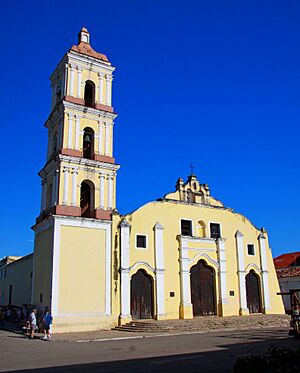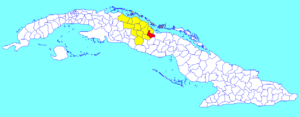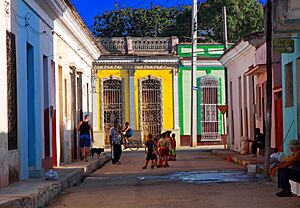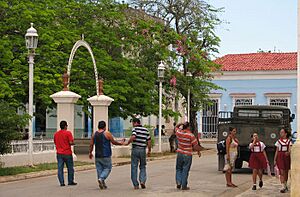Remedios, Cuba facts for kids
Quick facts for kids
Remedios
San Juan de los Remedios
|
|
|---|---|

Iglesia Mayor in Remedios
|
|

Remedios municipality (red) within
Villa Clara Province (yellow) and Cuba |
|
| Country | Cuba |
| Province | Villa Clara |
| Established | 1513 |
| Area | |
| • Municipality | 560 km2 (220 sq mi) |
| Elevation | 25 m (82 ft) |
| Population
(2022)
|
|
| • Municipality | 42,134 |
| • Density | 75.2/km2 (194.9/sq mi) |
| • Urban | 28,332 |
| • Rural | 13,802 |
| Time zone | UTC-5 (EST) |
| Area code(s) | +53-42-39 |
Remedios, also called San Juan de los Remedios, is a city and a type of local government area (municipality) in central Cuba. It is located about 5 kilometers (3 miles) from the northern coast of the island. It's the oldest Spanish town in what used to be the Las Villas province. Today, it's part of the Villa Clara province.
Queen Isabella II of Spain made it a city when Cuba was still a Spanish colony. Remedios is famous for its Parrandas, which might be the oldest and biggest festival in the Caribbean. The city's patron saints are John the Baptist and the Virgin of the Buenviaje.
Contents
Geography of Remedios
Remedios is about a four-hour bus ride from Havana, Cuba's capital. It is also about 50 minutes from Santa Clara. You can reach beautiful beach resorts like Santa María and Las Brujas in less than an hour. These beaches are north of the province.
Neighboring Areas of Remedios
The municipality of Remedios shares borders with several other areas. To the north, it borders Caibarién. To the south, it borders Camajuaní and Placetas. To the east, it borders Yaguajay, which is in the Sancti Spíritus Province.
Local Districts in Remedios
Remedios has 10 local districts, called consejos populares. These include El Carmén, San Salvador, and Hermanos Herrada within the city itself. Other districts are Heriberto Duquesne, Buena Vista, General Carrillo, Zulueta, Tahón-Francisco Pérez, Remate de Ariosa, and Circunscripciónes Directas (Chiquito Fabregat or San Agustín).
History of Remedios
Remedios is known as the eighth-oldest European city in Cuba. However, its exact founding date is not fully clear. Some historians believe it might be the second Spanish settlement on the island.
Founding of the City
Spanish nobleman Vasco Porcallo de Figueroa is thought to have founded Remedios. This happened sometime between 1513 and 1524. Some records suggest he founded it on April 13, 1514. Documents show that only Baracoa (1511) and Bayamo (1512) were founded before Remedios.
Some people think Remedios was founded even before Trinidad (1514). A story says that Vasco kept the town's existence a secret from the King of Spain. He did this to avoid paying taxes. But as the settlement grew, it had to be officially recognized.
Vasco received a large piece of land from Governor Diego Velázquez de Cuéllar. This was because his wife was the daughter of the Cacique (chief) of Sabaneque. At first, there was no local government for the town. After Vasco died in Puerto Principe in 1550, the town finally got its official charter.
Early Names and Growth
The town was first called Santa Cruz de la Sabana. It also had names like Santa Cruz de Vasco Porcallo and Santa Cruz de la Sabana del Cayo. By 1578, it was known as San Juan de los Remedios de la Sabana del Cayo.
During the 16th, 17th, and 18th centuries, the Spanish Crown gave land to settlers. This helped the population grow steadily. The economy of Remedios depended on farming and raising cattle. It became a main supplier of beef to Spain's colonies in Florida.
By 1678, the border between Remedios and Sancti Spíritus was set. Besides cattle, the sugar cane industry also grew. This industry relied on enslaved people for labor. By the late 17th and early 18th centuries, people also started growing tobacco, coffee, and cacao to sell.
The Move to Santa Clara
In 1682, a big disagreement happened among the settlers. Father Gonzalez de la Cruz claimed that evil forces had taken over the town. The Spanish Crown then issued a Royal Decree on January 29, 1684. This order told the settlers to move to a new place to avoid these "demons."
Eighteen families left Remedios. On July 15, 1689, they founded the village of Santa Clara. Today, Santa Clara is an important city and the capital of the Villa Clara province.
Historic City Center
The long history of Remedios is very clear in its city center. This area was declared a National Historic Monument in 1980. You can still see 17th-century Spanish buildings there that are well-preserved.
Population of Remedios
In 2004, the municipality of Remedios had a population of 46,482 people. The total area of the municipality is 560 square kilometers (216 square miles). This means there were about 83 people per square kilometer (215 people per square mile). By 2022, the population had decreased to 42,134 people.
Attractions in Remedios
Iglesia Mayor and Plaza Isabel II
The main attraction in the Plaza Isabel II is the Iglesia Mayor of San Juan Bautista. This church has 13 altars decorated with gold. In the past, pirates often attacked the city. To protect the gold, it was hidden under white paint. The French pirate François l'Olonnais was one of the most famous pirates to attack the town.
Between 1944 and 1954, the church was renovated. A rich Cuban helper named Eutimio Falla Bonet donated money for this. During the renovation, the real gold under the paint was found again. Falla Bonet was said to have family roots in Remedios. One of his ancestors helped found the city, and another was born there.
On the north side of the main square is another church, the Iglesia del Buen Viaje. Remedios is the only town in Cuba with two churches on its main square. However, the Iglesia del Buen Viaje has been left empty. It has leaks and is closed until the government approves repairs.
The Central Plaza, or Plaza Mayor, was restored in 1970. It is surrounded by old colonial buildings, beautiful statues, trees, palm trees, and a gazebo. Many towns in Cuba were designed this way, following a Spanish city plan.
The Famous Parrandas Festival
Many Cubans believe Remedios is special because of its Christmas festival, Las Parrandas de Remedios. This is one of the most popular local events. It happens every year between December 16 and December 26.
History of the Parrandas
The parrandas are considered the oldest festival in Cuba. Father Francisco Vigil de Quiñones, a priest at the Iglesia Mayor, first started them. He was worried that not enough people were coming to the Misa de Gallo (midnight mass) on Christmas Eve. So, he encouraged children to go into the streets. They would make noise with whistles, horns, and tin cans to wake people up. This way, people would have to get up and attend the mass. This noisy idea became a strong tradition among the people, and a festival grew around it.
Parrandas Competition
In 1871, the "parrandas" started following a special routine that is still used today. When the bells of the main church ring at 9 o'clock on the night of December 24, two neighborhoods show off their creative work. They have spent the whole year preparing for this competition.
During the "parrandas," there is a strong competition between two neighborhoods. San Salvador is one, and its colors are red and blue, with a rooster as its symbol. The other is El Carmen, represented by the color brown and a globe. The memories of these celebrations are kept at the Museum of Parrandas. This museum opened in 1980 in a 19th-century building in Remedios. It has photos, documents, and handmade items related to the festivities.
Notable People from Remedios
- Alejandro García Caturla (1906–1940), a famous composer.
- Federico Laredo Brú, a lawyer and politician.
- José Luis Nápoles, a sports journalist and TV anchor.
- Jorge Luis Toca (born 1975), a former professional baseball player.
- Dayán Viciedo Pérez (born 1989), a professional baseball player.
- Yosver Zulueta (born 1998), a professional baseball player.
Sister Cities
Remedios has special connections with other cities around the world, known as sister cities:
 Ann Arbor, United States
Ann Arbor, United States La Orotava, Canary Islands, Spain
La Orotava, Canary Islands, Spain Normal, Illinois, United States
Normal, Illinois, United States
See also
 In Spanish: San Juan de los Remedios para niños
In Spanish: San Juan de los Remedios para niños




